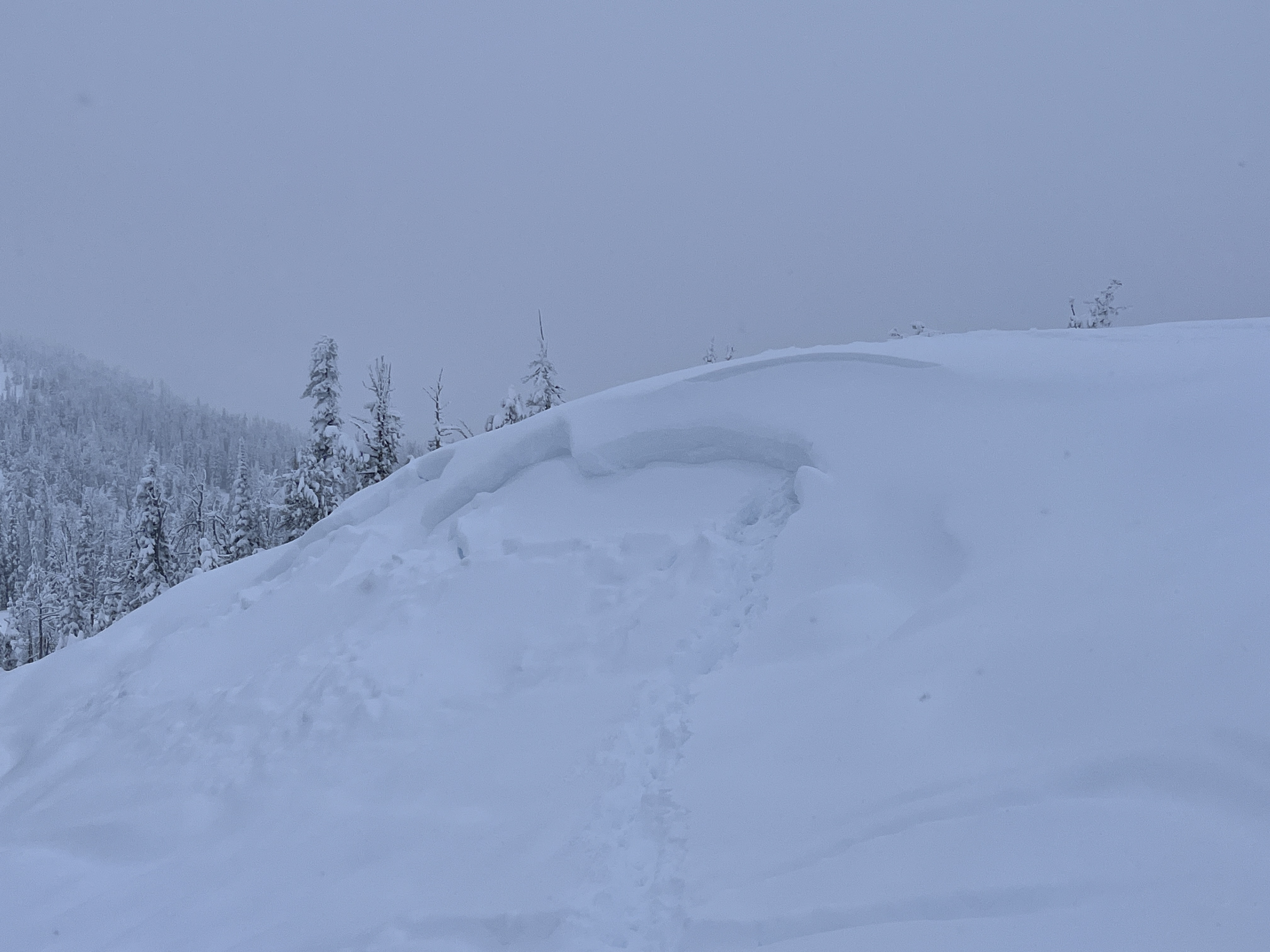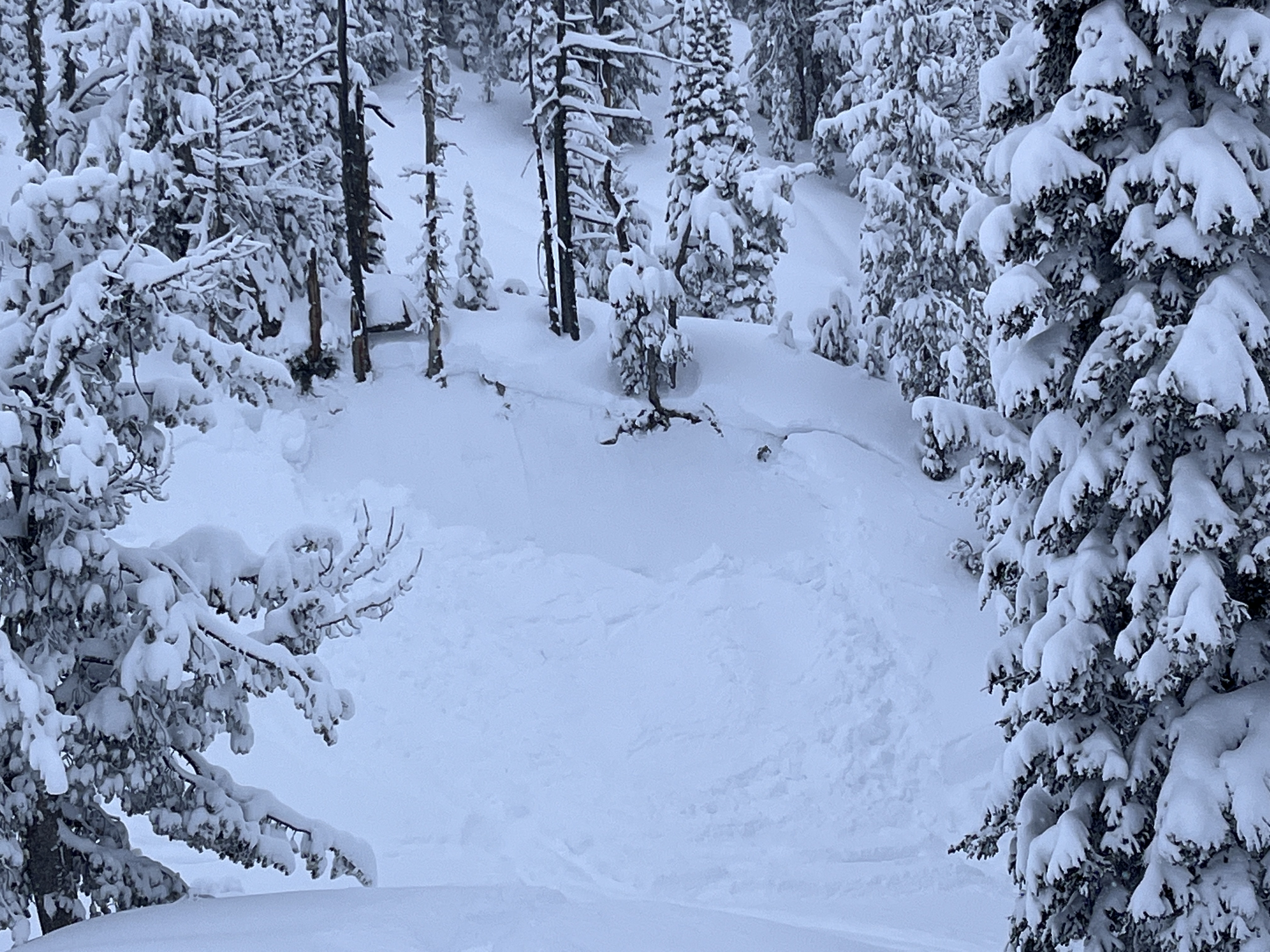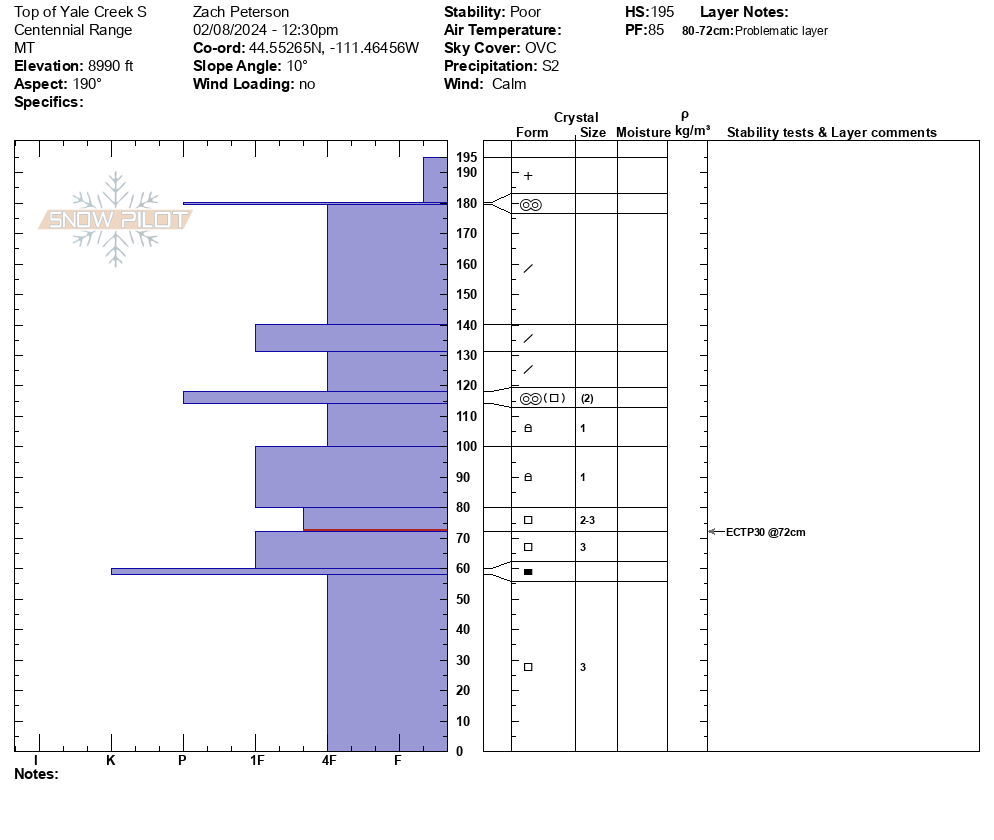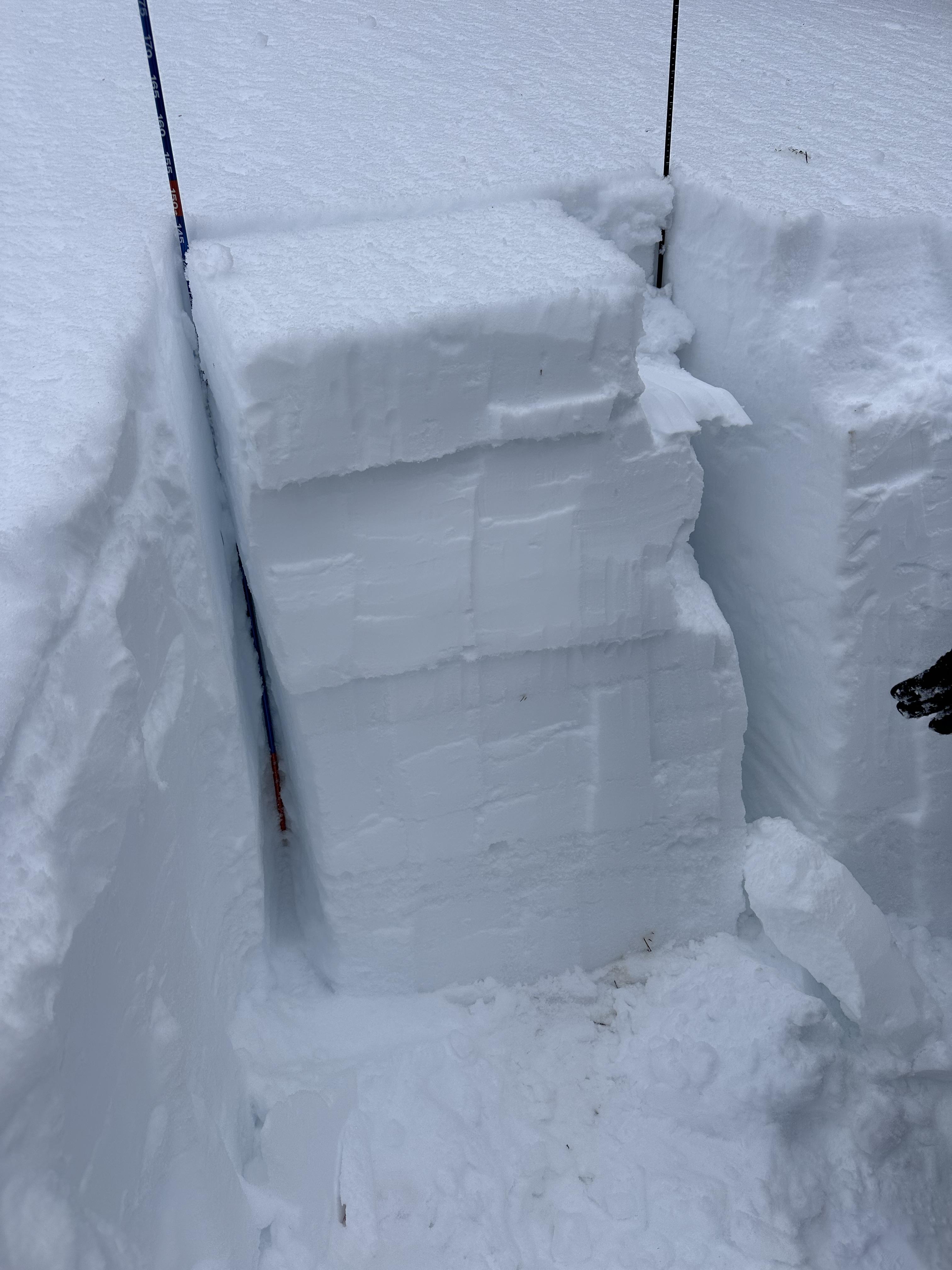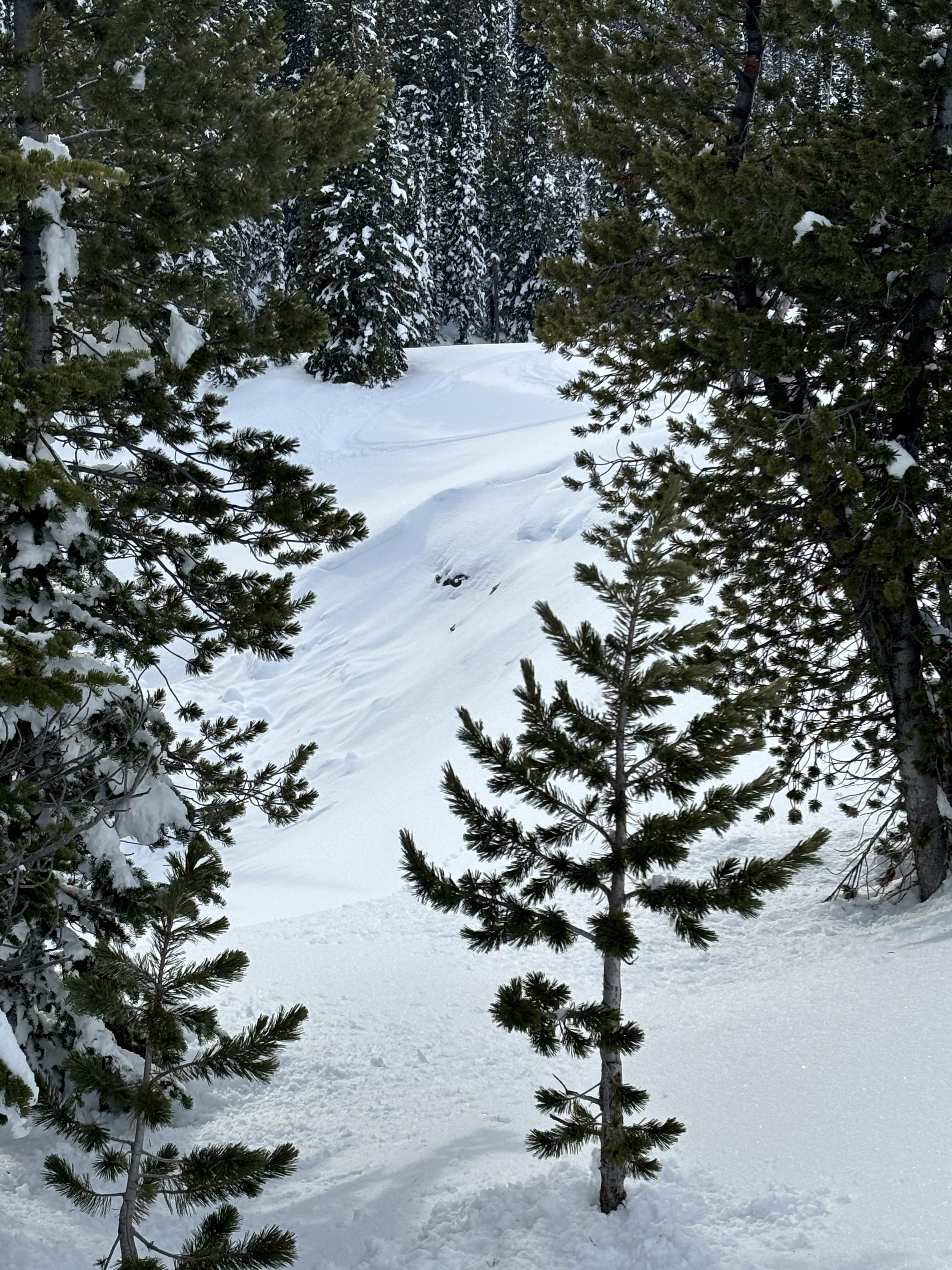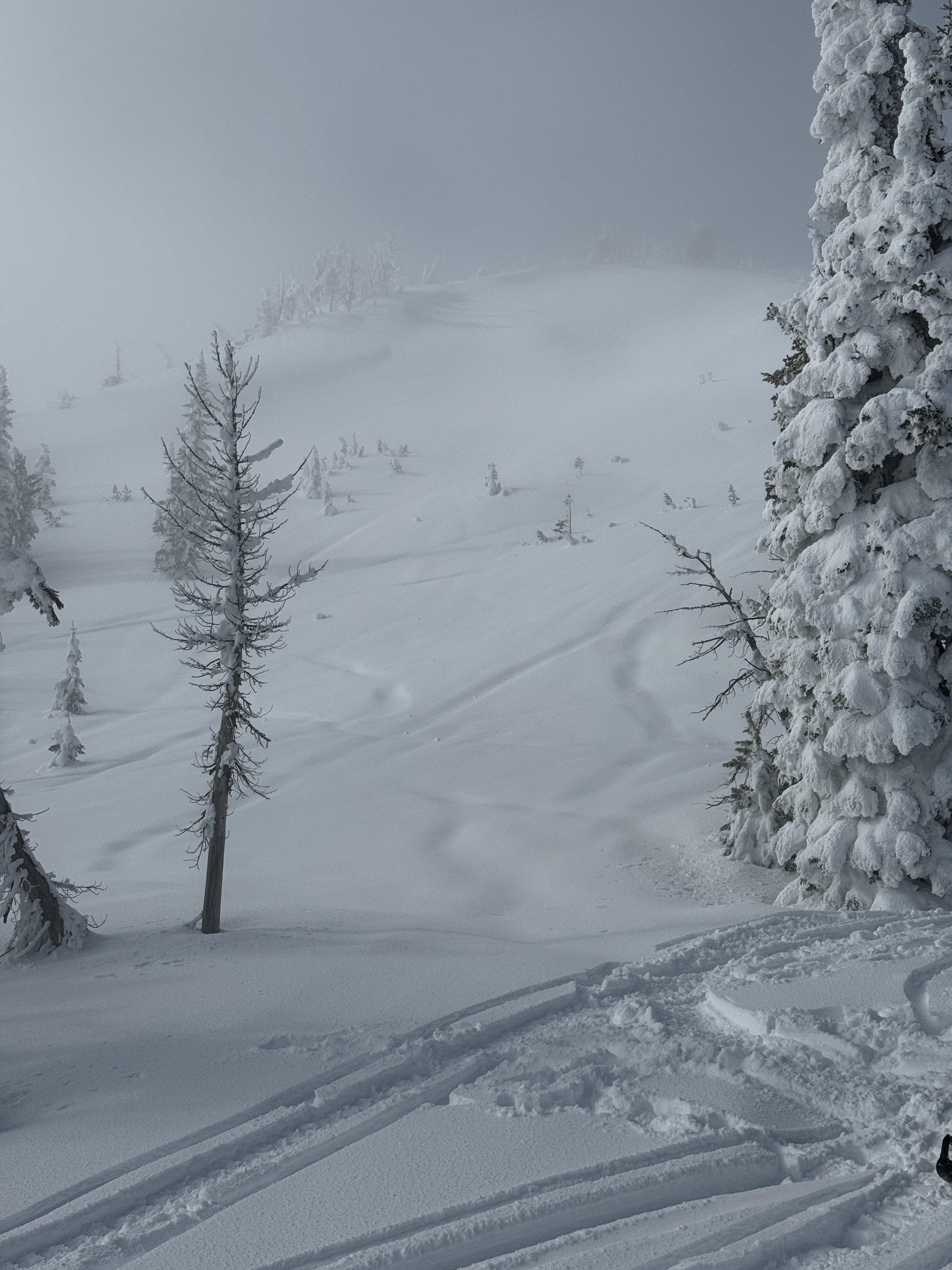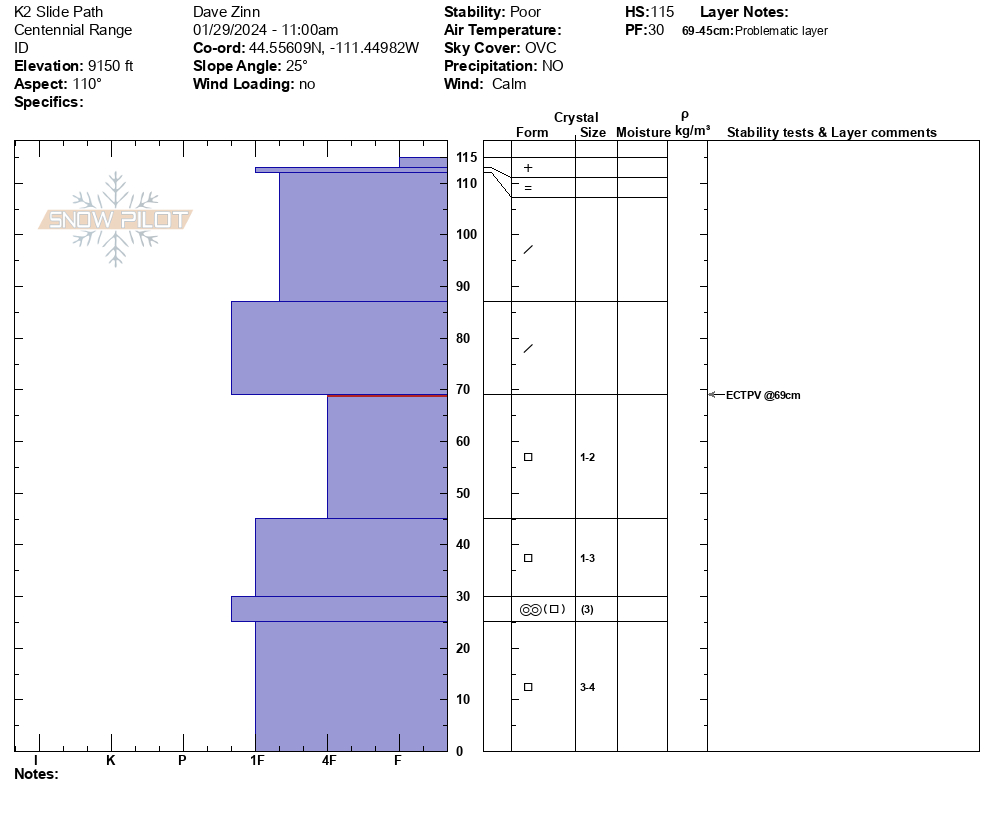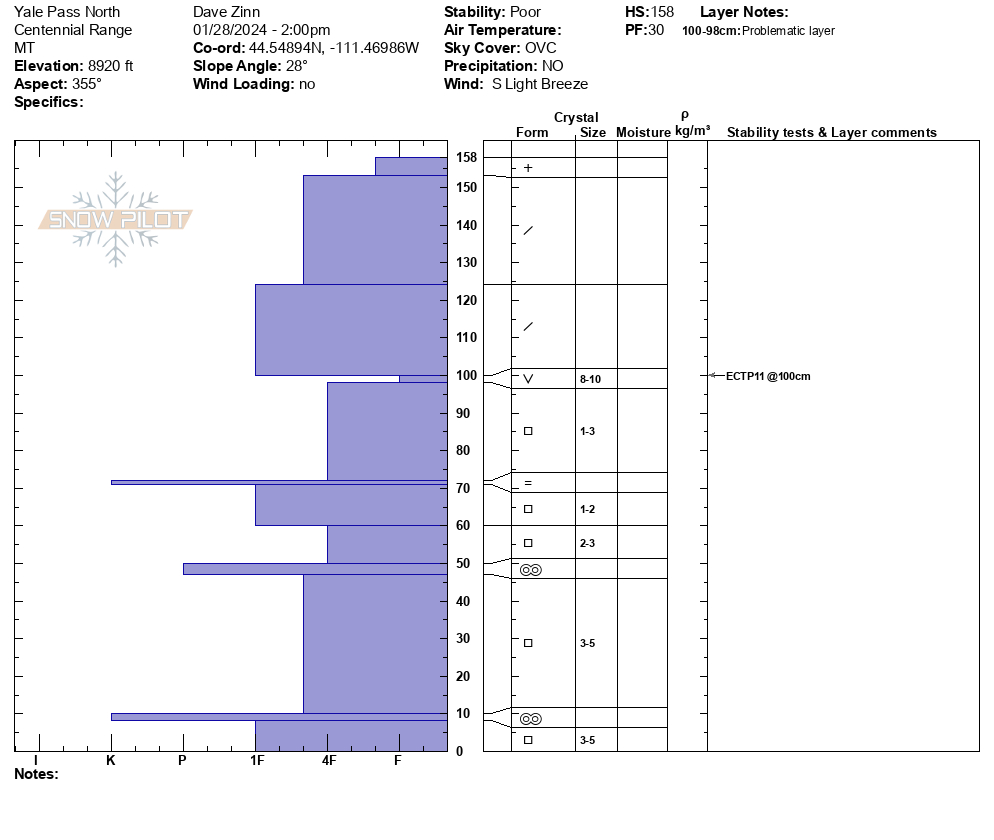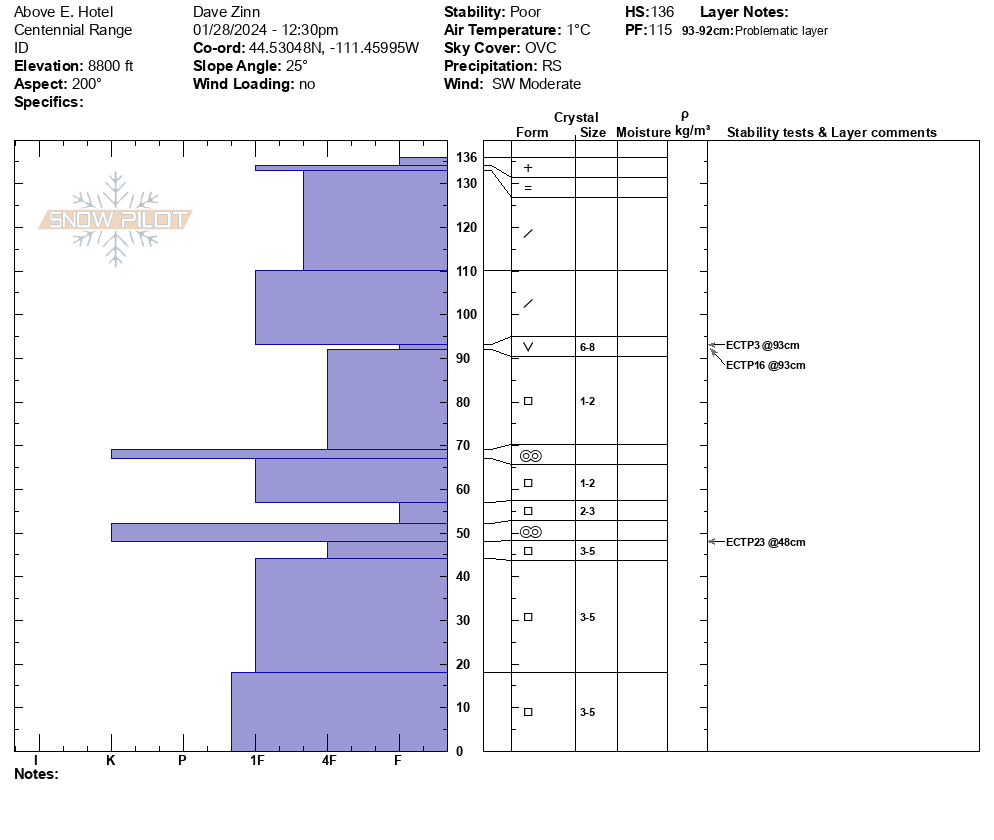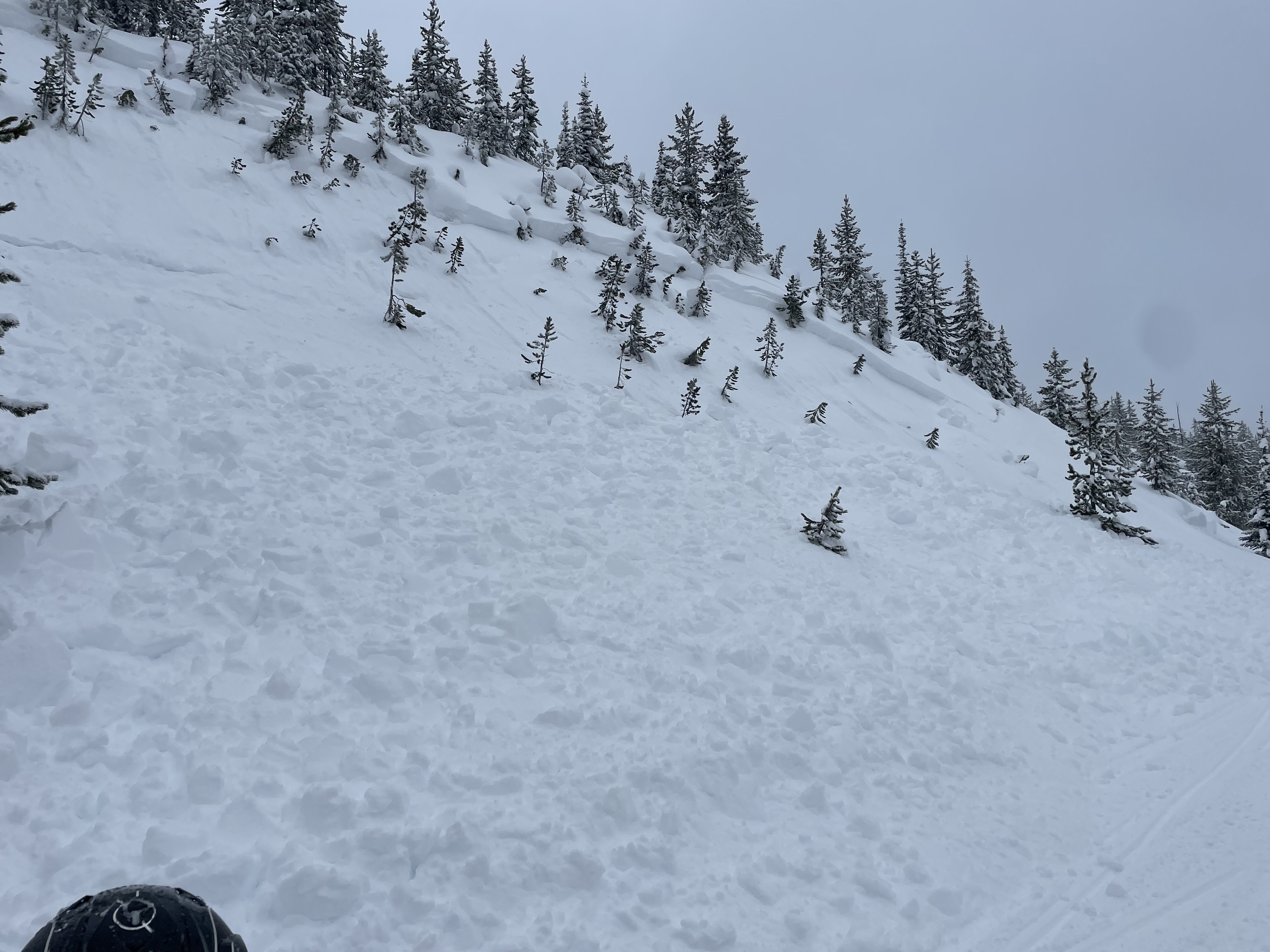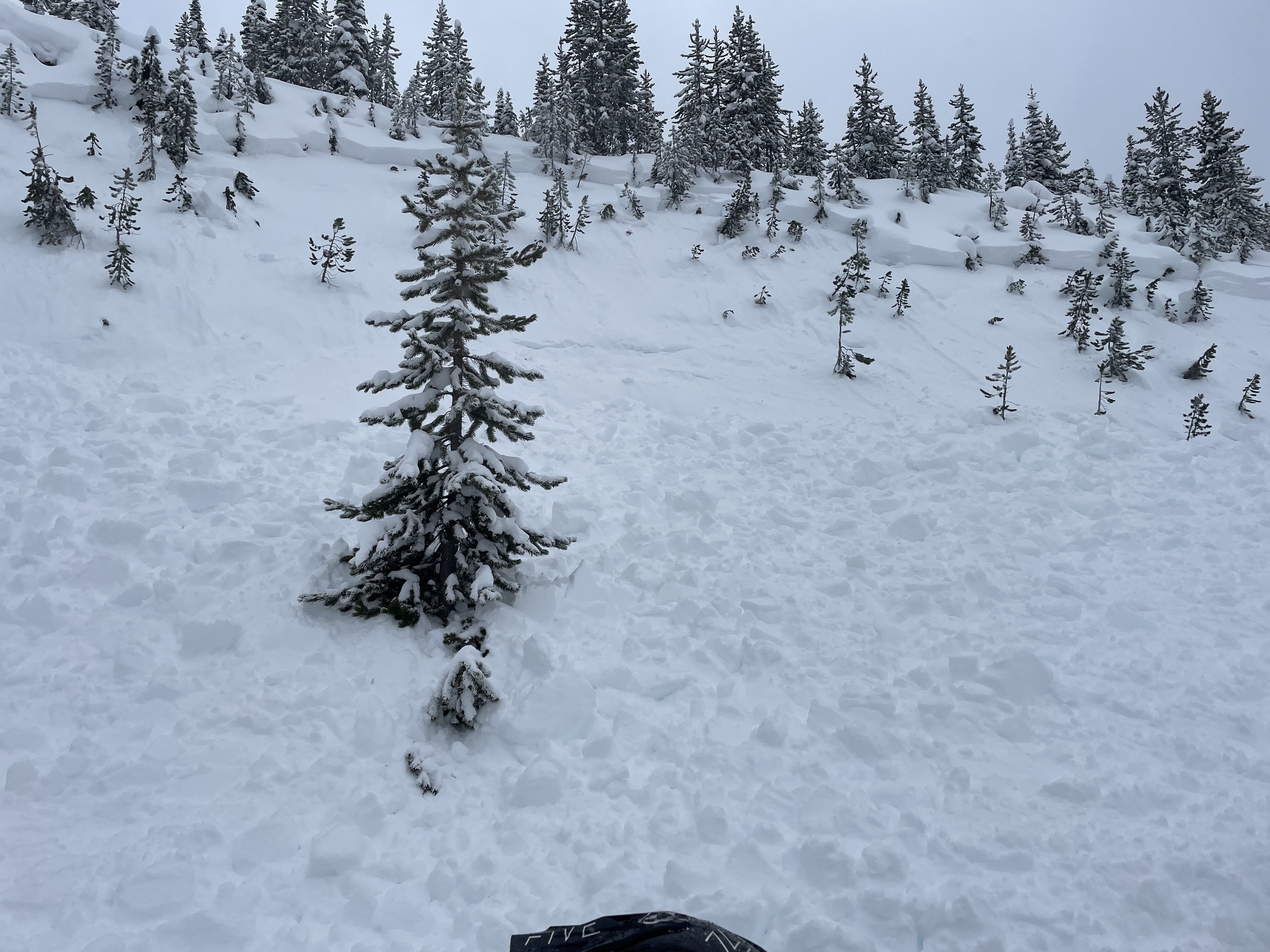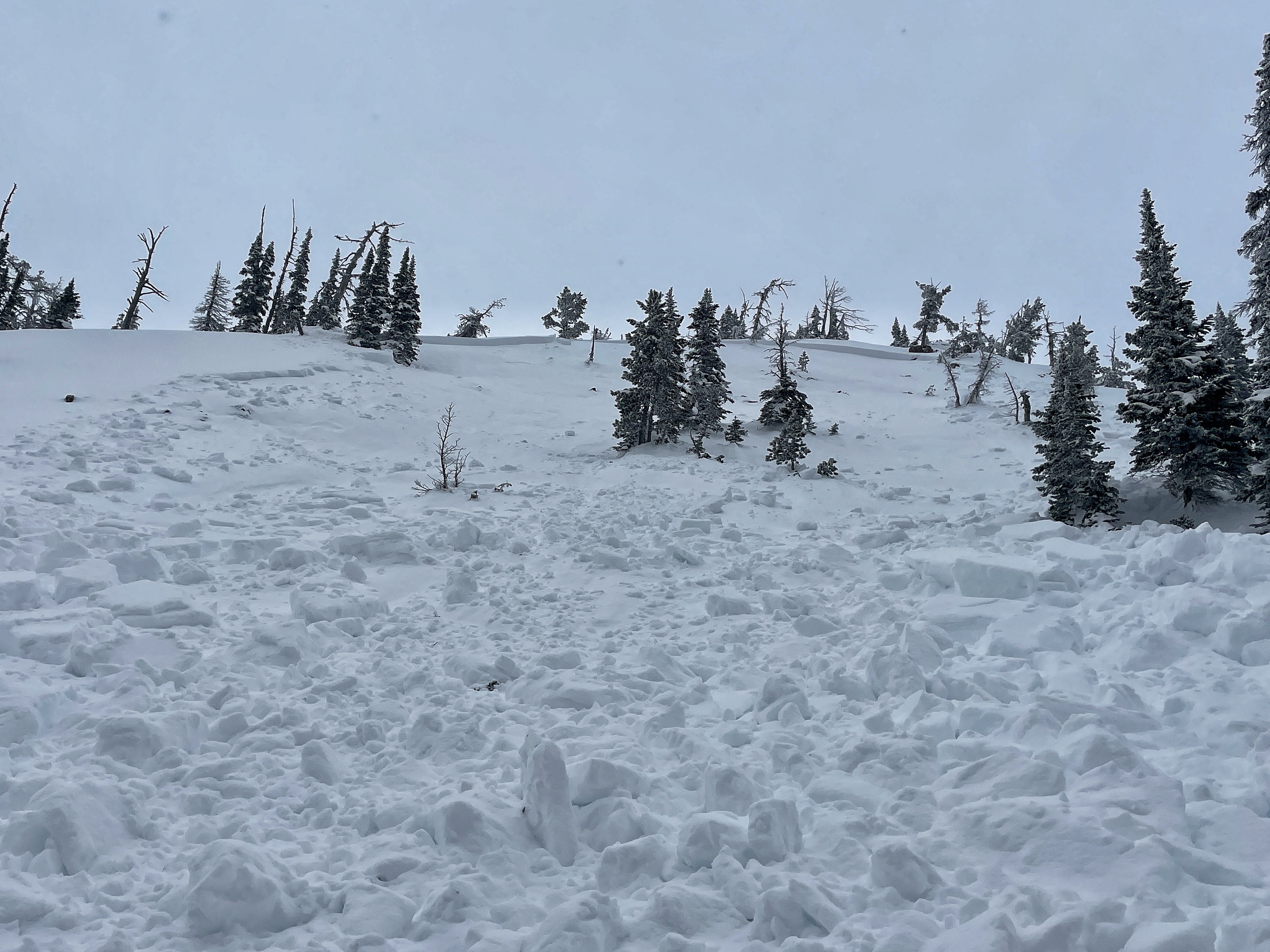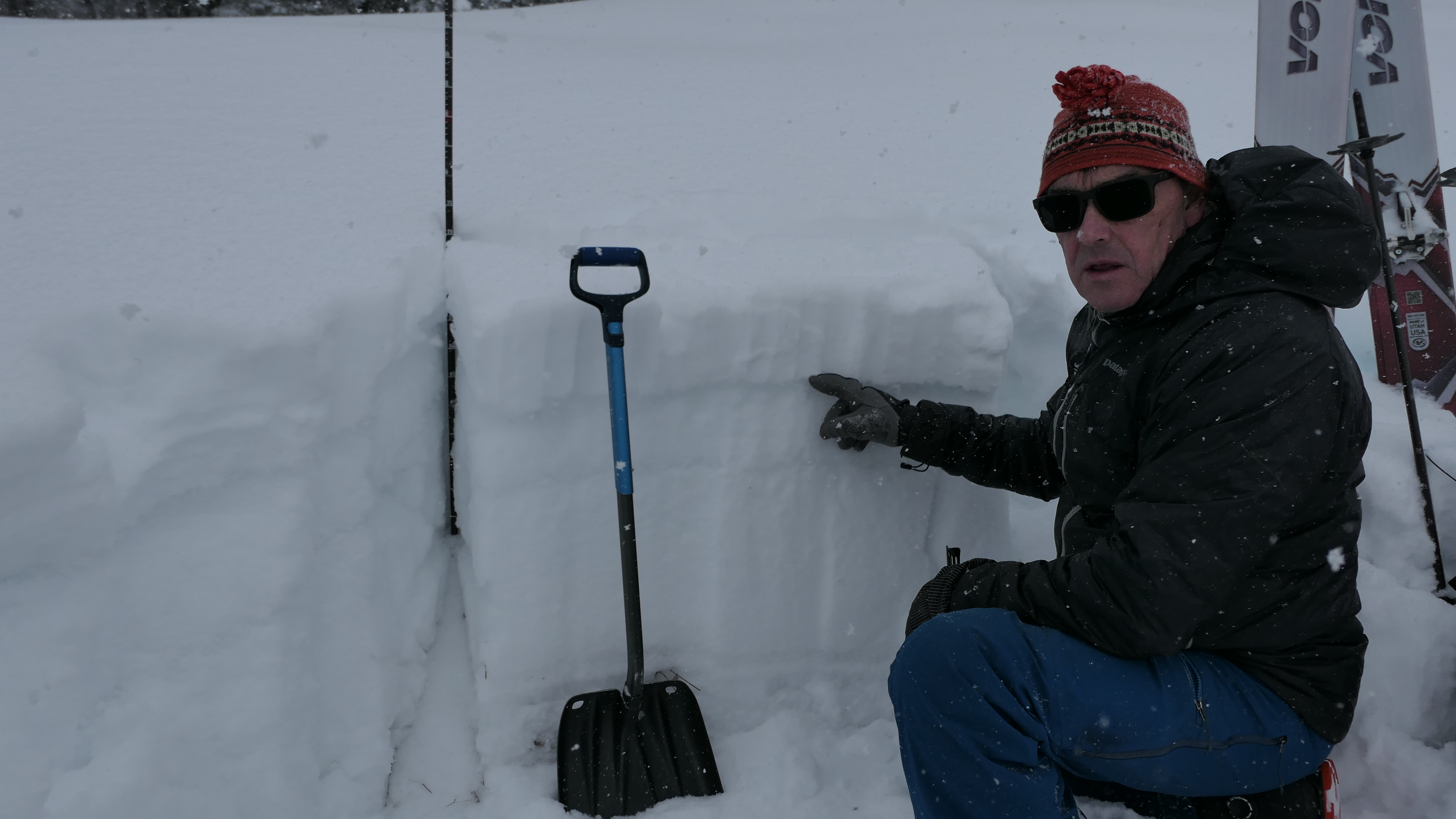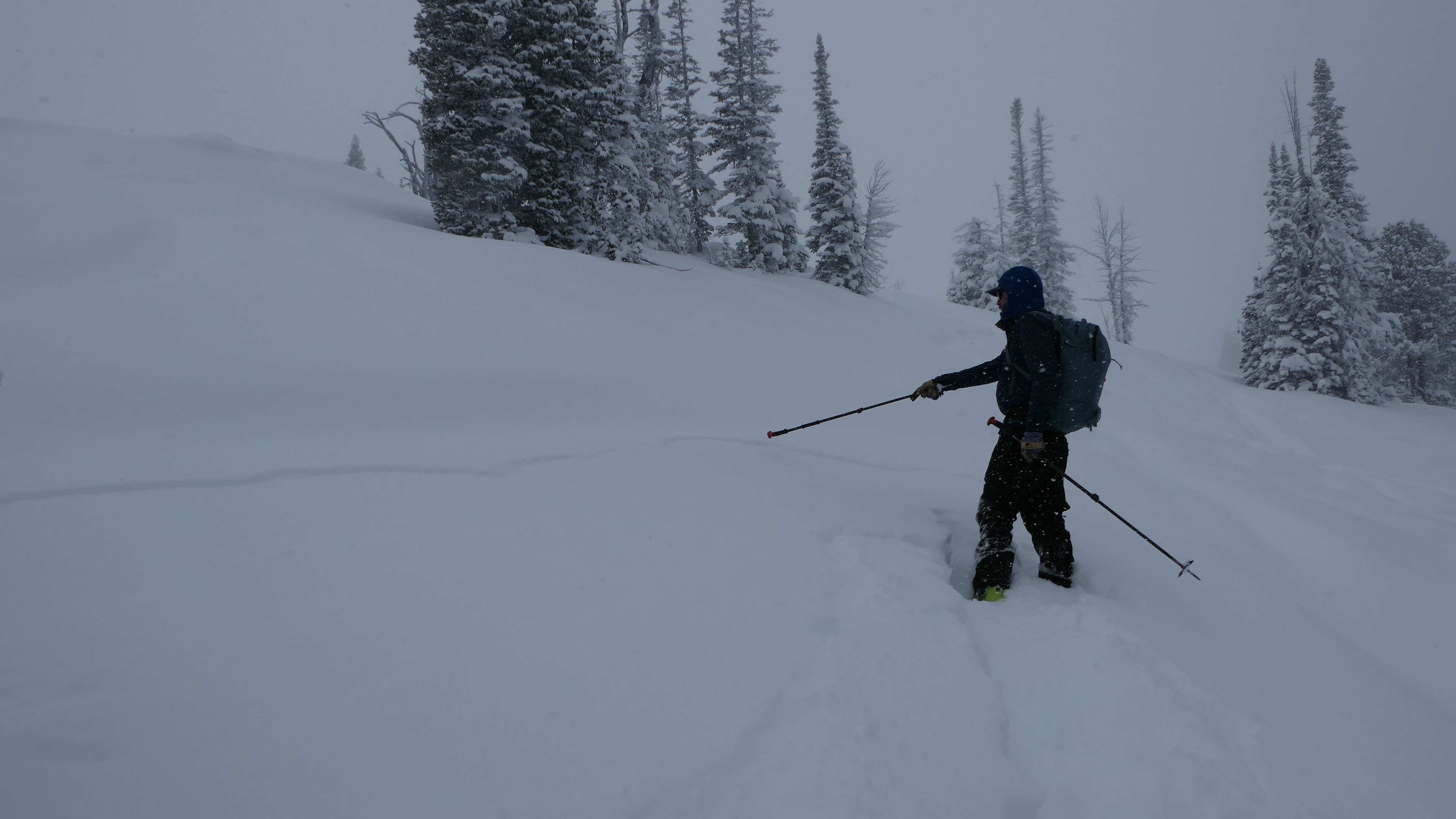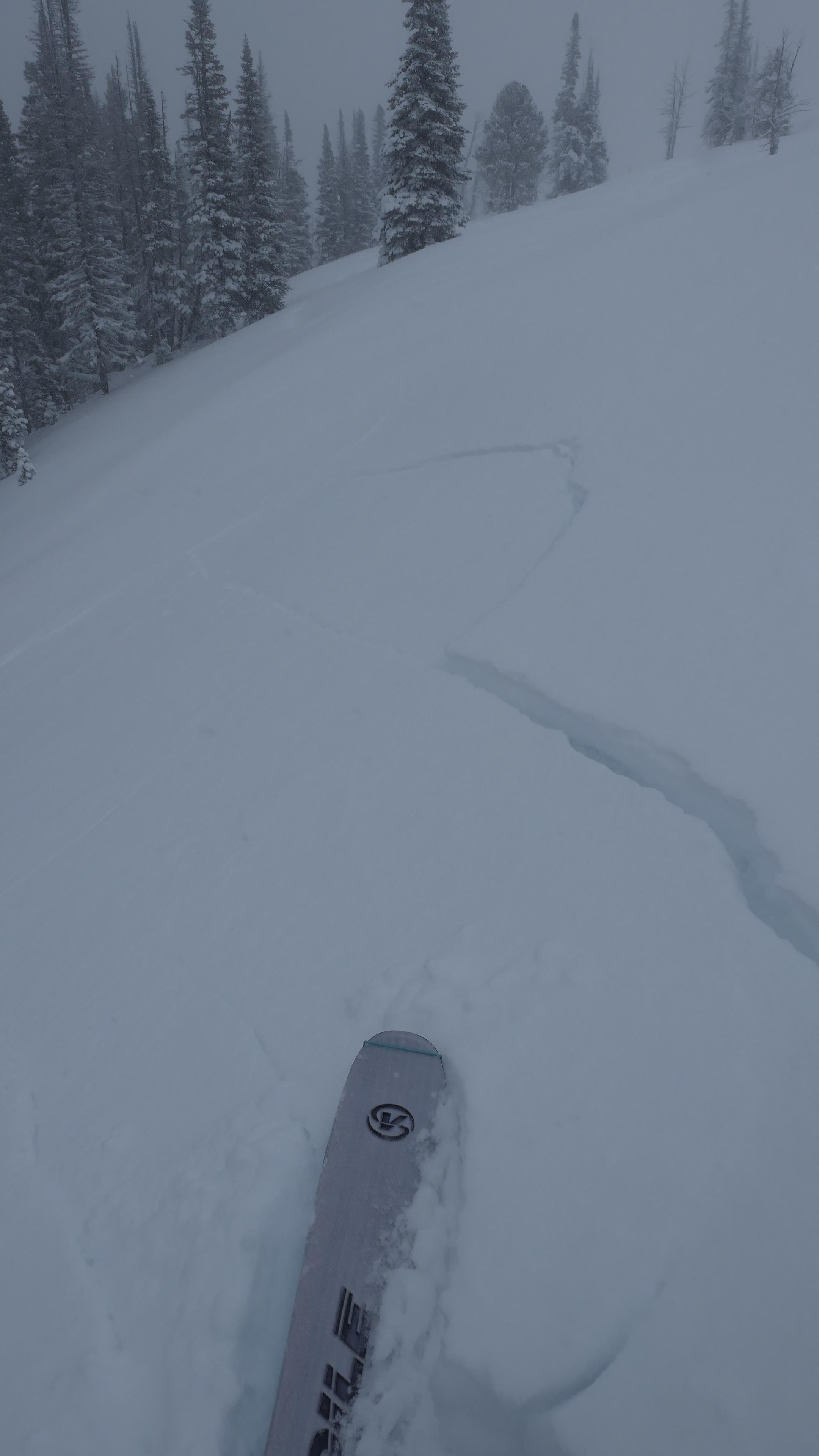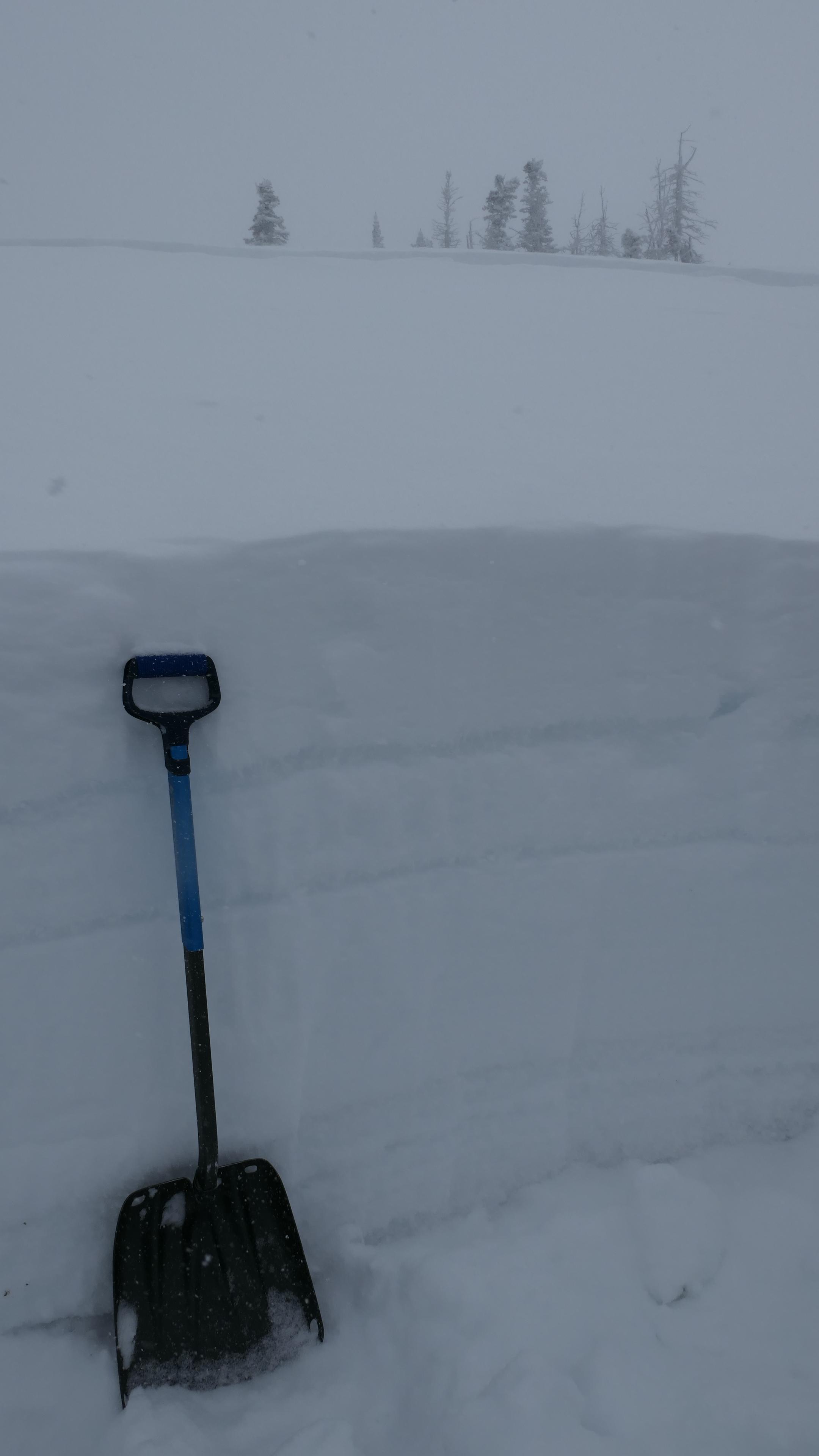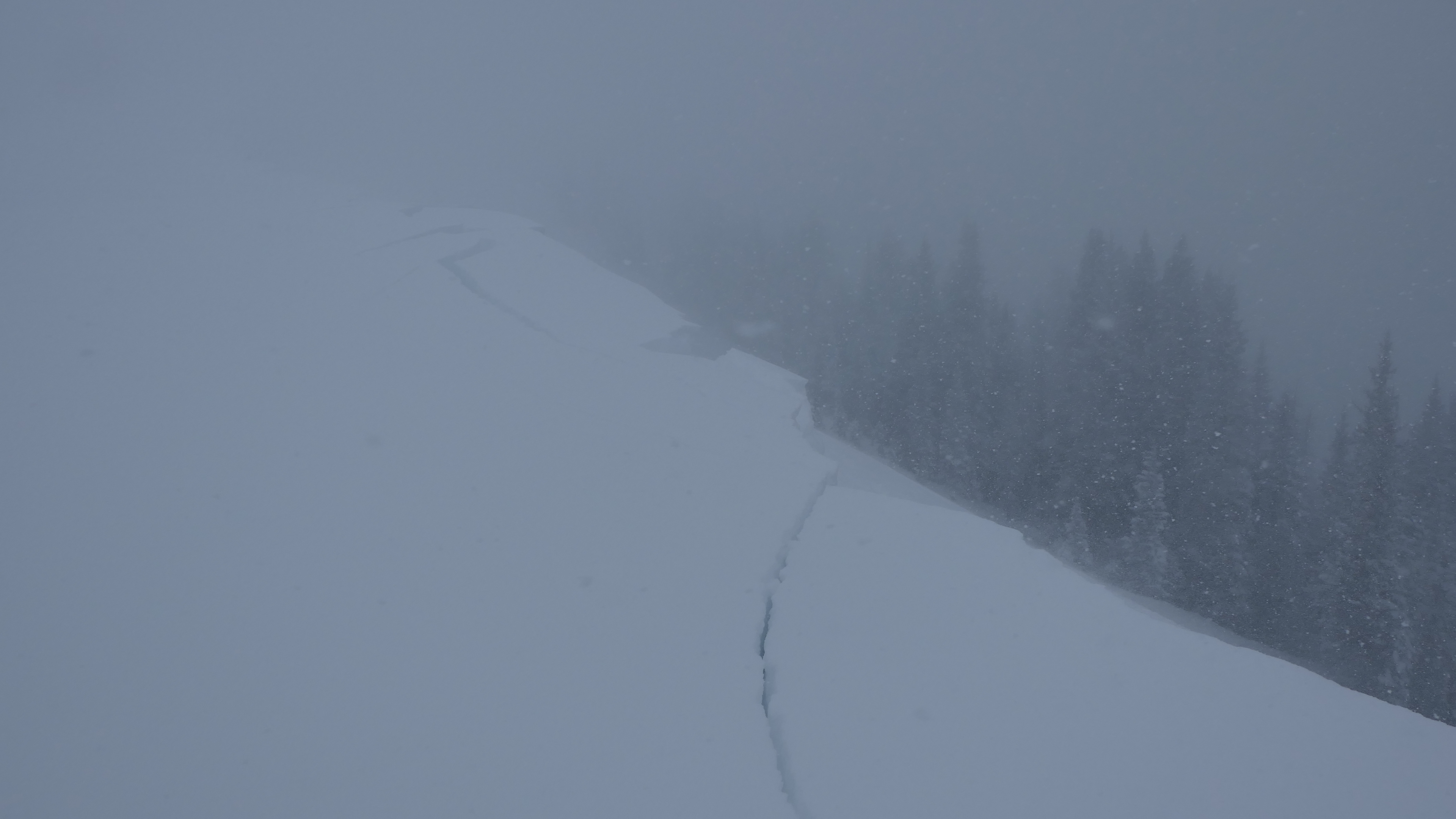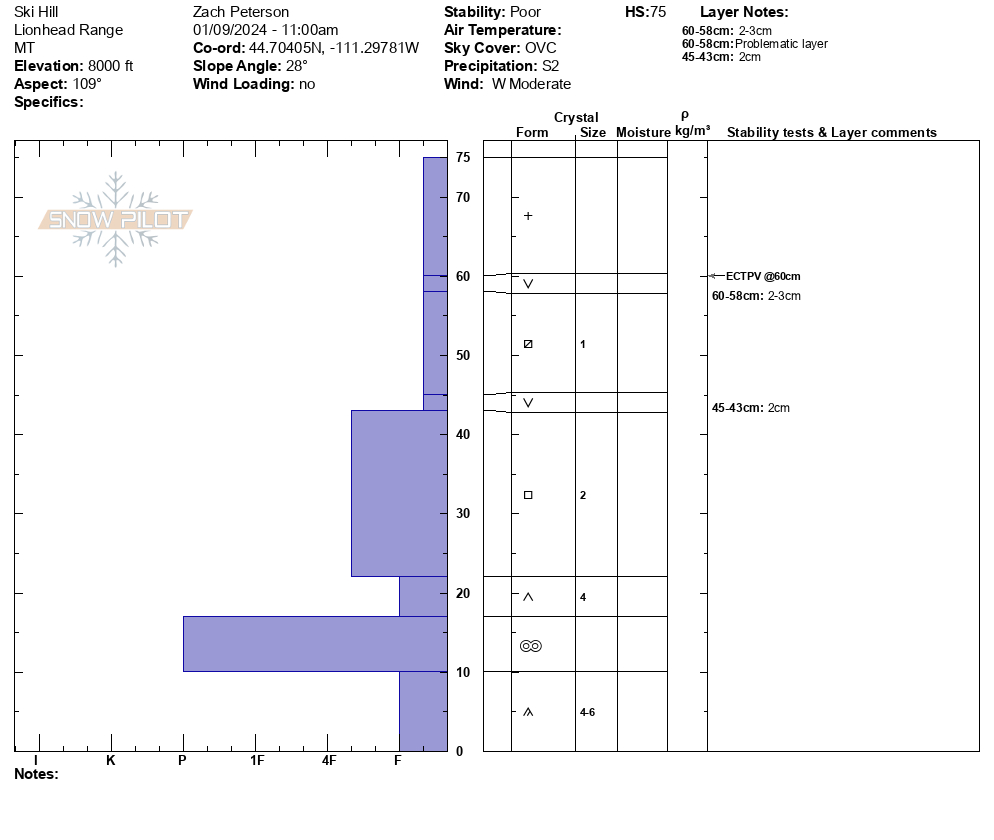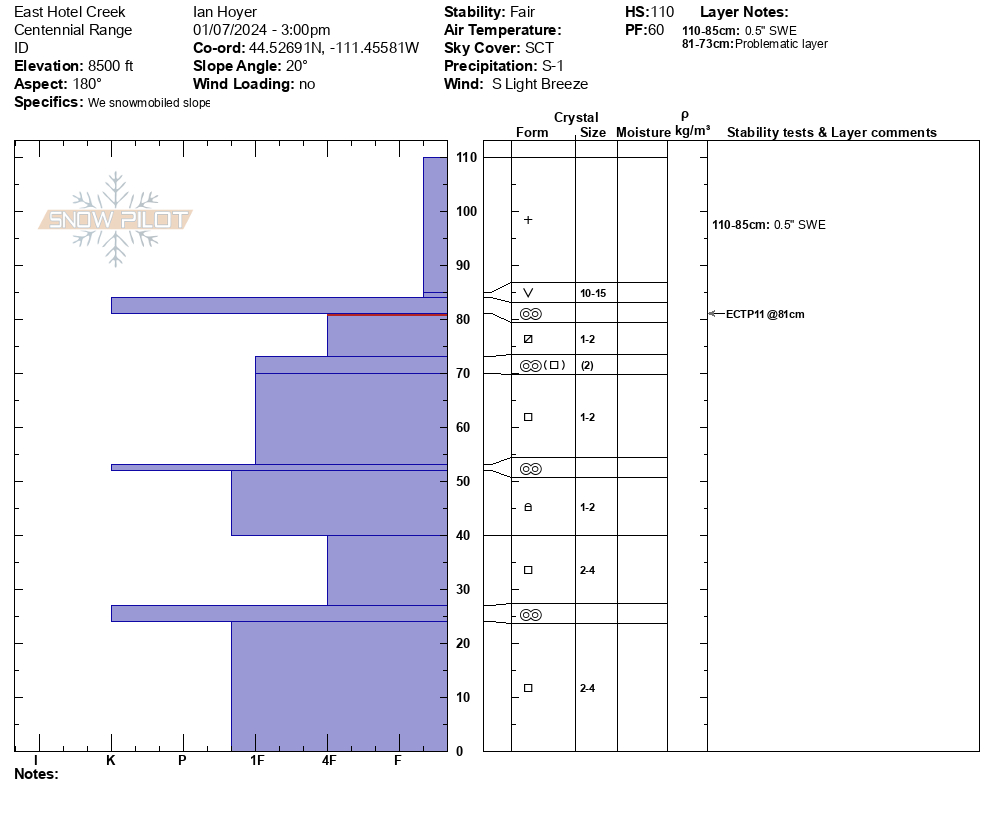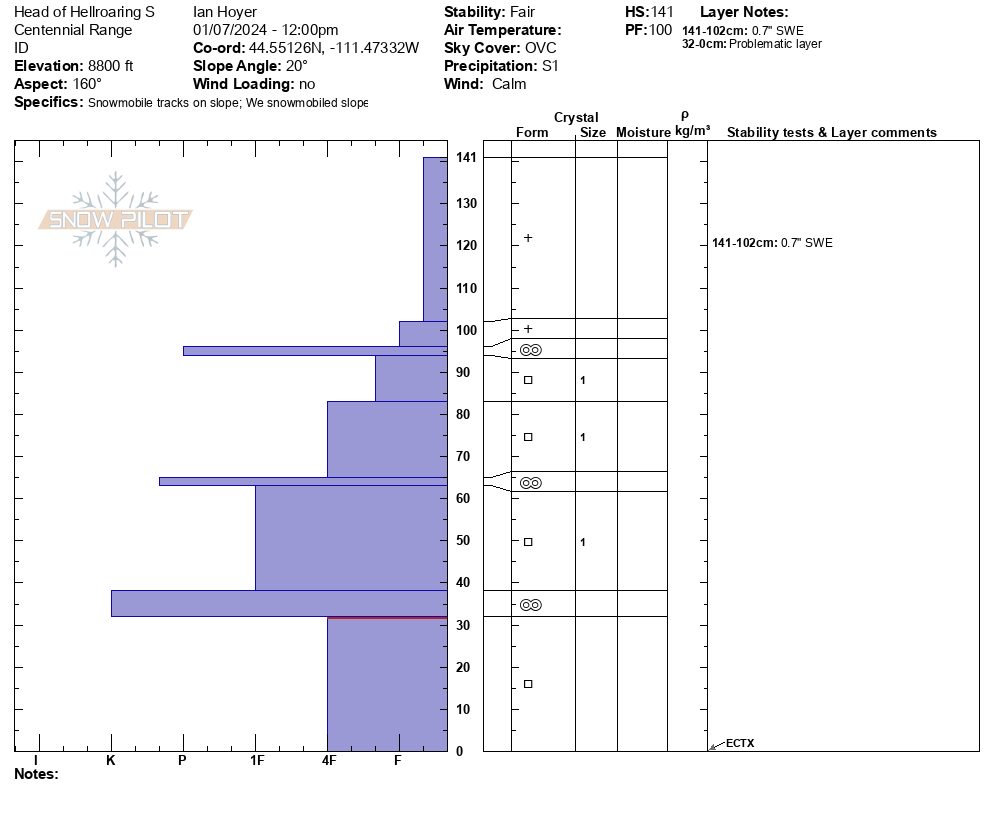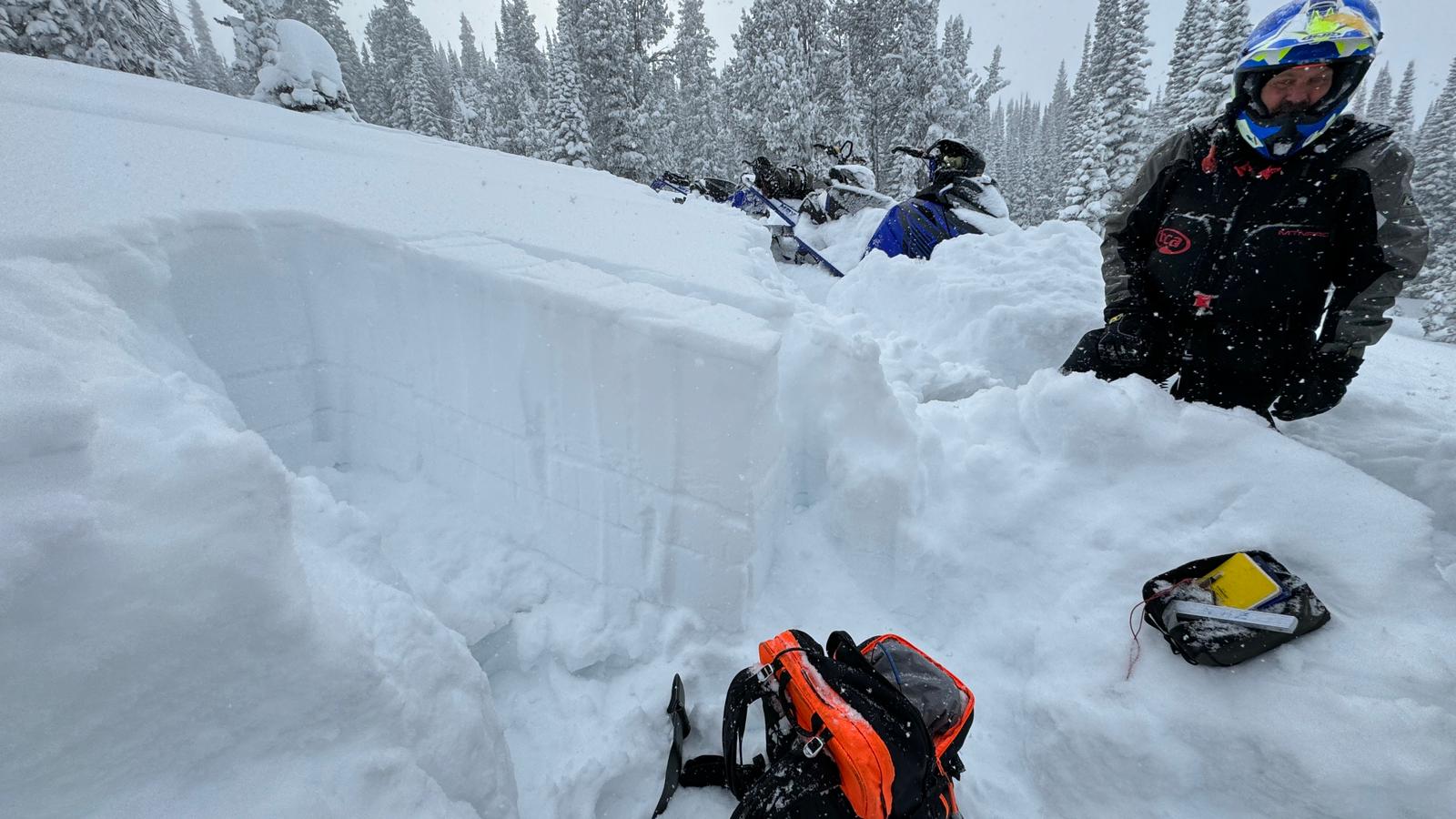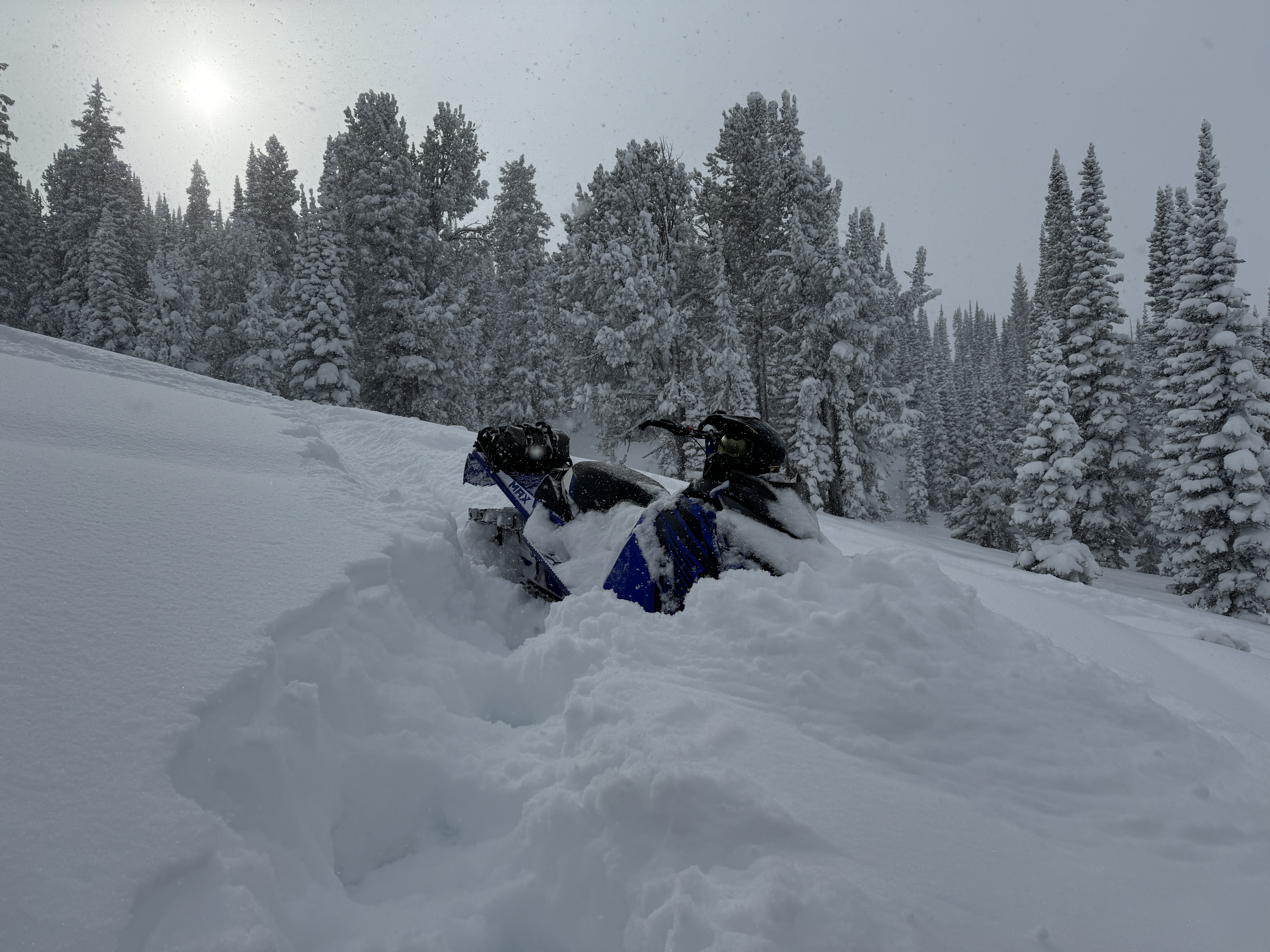Snow Observations List
We rode into Yale Creek today. At the head of the creek, we stopped and dug on a south-facing slope at 9000'. We found 30" of new snow that has fallen over the last week on top of an already unstable snowpack. From here we continued up Yale Creek and on a small NE-facing slope, we saw an avalanche that was triggered by snowmobilers within the last couple of days. This avalanche was 2-3' deep and 100 feet wide and failed on weak faceted snow near the ground. It did not run far vertically because it was such a small slope. We dug near here on a SE facing slope and saw a similar setup as earlier with 30"+ of new snow overlaying weak snow.
On our way out, we saw a small freshly triggered avalanche. This was in a small gully and failed on weak snow near the ground 1-2' deep. With poor visibility, we did not get an opportunity to see any avalanches on larger slopes. However, seeing avalanches on small protected slopes is a good indicator that there are likely avalanches on larger steep slopes we could not see.
Wind was calm to light out of the south and snow continued through the day, with 1-2" of snow falling while we rode.
Full Snow Observation ReportFrom FB:
No avalanches observed. A foot of new snow in 24hrs, 3-4 inches throughout the day. Strong wind gusts in the morning into early afternoon, drifting in open areas and higher elevations. Experienced multiple whoomphing in an open flat area.
Full Snow Observation ReportFrom email: "Temp 27. 4'' new snow, Rate S1, Sky OVC. NE aspect, SE winds, L observed localized drifting. Elevation 7790’. conducted several CT tests scored CTM and CTH (SC) ECTP 21, NE of Two Top on a layer of SH 35cm from surface. New snow on a melt freeze crust very reactive CTE 15cm from surface. Possible new layer of concern as new snow accumulates. No recent avalanches observed."
Full Snow Observation Report120 cm HS, OVC, E aspect, 6" new snow, -4c air temp, 14 deg. incline, blowing snow: none. ECTP 22 at 101 cm
Full Snow Observation ReportNorth of sawtelle peak between sawtelle and Bootjack. General observations of surprisingly low snowpack. Traveled from red rock parking lot to flats to Bootjack then south toward sawtelle then east to the flats and back north to red rock parking. The northern area had on average 6-10 inches, the southern area had 12-15 inches. Elevations were between 6300 and 7200 feet. Aspects were mostly NW to N to NE to E.
Full Snow Observation ReportFrom email on 2/2/24: "We received a call of a missing snowmobile in the Keg Springs area of Island Park at 1642. The missing snowmobiler arrived at 1800 hours at the rental property his party is staying at and said he had self-extricated from an avalanche."
Full Snow Observation Report
Lots of collapsing and whomping in the snow, 3 avalanches seen in hell roaring creek and performed a few snow pit tests with an ECTP21 with 2 failures at 25 cm and 70 cm.
Full Snow Observation ReportOver 15 slides spotted on our ride today. Both large and small. Mostly south facing slopes with a large one on a north facing slope. Several hills with visible cracking and ready to let loose.
Full Snow Observation ReportWe spent the last two days riding in the Centennial Mountains. We had limited visibility for spotting avalanches but we did catch sight of one slide on a steep slope above Yale Creek.
There were fewer in-your-face signs of instability, such as the avalanches, shooting cracks, and collapsing, which were a staple of conditions last week. However, when we dug deeper (get it), we found the ingredients for a human-triggered avalanche in every snowpit we explored. All failed and propagated on the surface hoar or near surface facets buried 1-2 feet deep, with results varying from ECTV to ECTP21 indicating human-triggered avalanches are likely.
I told my riding partners that, in some ways, I am more worried about people triggering avalanches this week than last because last week, incredibly obvious signs of instability and avalanche warnings largely kept people out of avalanche terrain. This week, the feedback is not as clear, and folks may get tempted by steeper slopes. Our recommendation is to play the long game. Persistent weak layers demand persistent patience. Our best tool to have safe and enjoyable days in the mountains remains conservative terrain selection and sticking to slopes less than 30 degrees.
Full Snow Observation ReportThe stripes of surface hoar we found in the Centennials do not seem quite as prominent or reactive as those in the Lionhead area. I was disappointed that we did not get the visibility windows we needed to really go avalanche hunting, but the weak layers told a story that is largely consistent with the surrounding areas.
The riding is getting really good. The snow is supportable with excellent traction.
The danger was CONSIDERABLE but from what I was able to see, it seemed like it was moving to the lower end of CONS. Not totally convinced.
Conduction ECT test.
Observed two well preserved layer of surface hoar
1st layer- 45 cm below surface. 3cm thick layer of surface hoar.
South of two top north west of trail intersection #20. (saturday 1/27)
rode low angle stuff all day, creek bottom is normally not visible and its down to dirt. The whole area (south of two top) seemed really shallow and west facing slopes were very windswept when exposed, but filled in down low.
We found that the weak layers are all over the place after the warm weather and rain. Super faceted snowpack everywhere we went and even in low angle trees you could stick your hand in next to where a snowmobile track was and break a slab off. When rolling sleds over on a small hill we broke off lots of big 3' x 3' chunks down to the old really deep weak layer.
We did not see any avalanches.
Full Snow Observation ReportCollapsing snow could be felt underneath my sled all day up Black Canyon Loop trail, east of Island Park. There was a moment where shooting cracks spread from my ski tips to about 10 yards away on flat ground. The canyon just north my location was probably steep enough to slide.
Full Snow Observation ReportSpent a day digging out the Hut in the Centennial Saturday 1/20. Our hasty pit, 20 deg. SW aspect at 7,000’ about 1/2 way into the hut showed 75 cm snow depth and various sized facets to a depth of 45 cm from the ground overlain by new snow. The structure was poor, and weak but we did not observe propagation in an ECT. Snow surfaces were damp on all aspect that we touched below 8,000’, pin wheel rollers on many steep slopes could be seen near the creek. Plenty of collapsing and “whumfing” on the way in kept us wary. Snow depths below 7,000 feet were as shallow as I have seen in 10 years operating the hut.
Full Snow Observation ReportFrom interaction at the gas station:
“We were riding out from Island Park. We saw dramatic, collapses, and shooting cracks. I side-hilled a small slope and triggered it 1.5 to 2 feet deep. I have never seen such unstable snow.”
Full Snow Observation ReportWe dug pits and rode on Sawtelle Peak. At 9,100 feet we had unstable test results (ECTP13 x 5; ECTP10 x2; CT4, Q1). When the clouds lifted we could see a crown of a snowmobiler triggered slide that occured yesterday. It broke on the buried surface hoar and facets about 1.5 feet under the surface. Recent snow and wind-loading has created dangerous avalanche conditions.
The avalanche:
From FB: Taylor’s Fork today, 8-10 inches of new snow last night. A few small slides but tons of cracking.
Full Snow Observation ReportFrom FB
Yale creek opposite side of creek from maintenance shack at 7600 ft with 105 cm on a 27 deg slop 62 deg NE facing. First column test had an CTE - 1 failing at 75 cm and then CTE-4 failing at 63 cm
ECTN - 5 with no propagation across entire slab
Very deep facets with 4 melt freeze layers with one being 7 cm thick, surface hose layer very visible and one of the failure layers
Full Snow Observation ReportWe rode into Lionhead today towards Lionhead Ridge. Cloudy with consistent snowfall through the afternoon. The wind was out of the west and was blowing snow around at all elevations. We stopped at Ski Hill and dug on an east-facing slope at 8000'. While isolating our ECT we had a failure 15cm below recent snow on a well-preserved layer of surface hoar (ECTPV). From here we transitioned to skis and continued up to the ridge. As we approached the ridge we experienced frequent collapses and shooting cracks that extended 20 feet in front of our skis. At a rollover, while breaking trail there was a collapse, and 3" wide cracks shot in all directions and the slab moved a few inches downhill. If this terrain had been any steeper it certainly would have been an avalanche.
We continued towards the ridge and intentionally remotely triggered an avalanche on the steep terrain below the south end of the ridge. This avalanche broke 1000' wide, 18" deep, and ran 100 vertical feet to the trees. This avalanche likely happened on a layer of buried surface hoar similar to what we found in our pit on ski hill. Strong west winds at the ridgeline continued to blow snow and made for poor visibility but as we continued more cracking was seen and cornices were remotely triggered when walking near them.
Snowfall and strong winds continued making for poor visibility at ridgetop. We skied back to the snowmachine and portions of our skin track had been filled in by the steady wind and snowfall.
Full Snow Observation Report
We will go to an Avalanche Warning tomorrow for IP and Lionhead.
We rode up to the head of Yale Creek, down a bit into the head of Hellroaring Creek and then returned via the East Fork of Hotel Creek. The depth of new snow increased dramatically with elevation from approximately 8" (0.5" SWE) at 8000 ft to 18" (0.7" SWE) at 9000 ft. The new snow had little cohesion.
We found buried surface hoar on both shady and sunny slopes. Sunny slopes had multiple melt-freeze crusts interspersed with weak facets throughout the pack. On shady slopes the lower snowpack was entirely faceted. We had an ECTP11 on facets just below the old snow surface on a S facing slope. Otherwise our results were ECTX and ECTN with slab fracture in Propagation Saw Tests (likely because neither the facets or new snow were cohesive enough to act as a slab in our tests).
Wind, settlement or more snow could quickly make for a cohesive slab. When that happens, with so much new snow and such weak snow beneath it conditions will rapidly become unstable.
We saw no avalanche activity and had no cracking or collapsing.
Full Snow Observation Report
